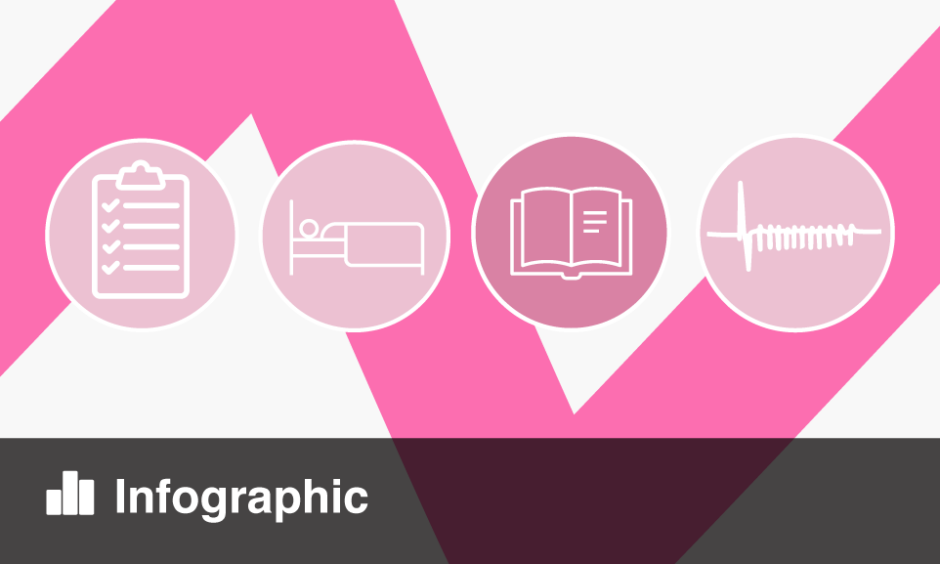Avery Rogers
Sleep is becoming an increasingly scarce commodity, especially among adolescents. For a teenager to perform at maximum cognitive levels, sleep researchers recommend getting an average of 9 hours of sleep per night. Nonetheless, the average high school student in the USA gets about 7 hours of sleep per night, and the average high school student in South Korea sleeps only 6 hours per night. The discrepancy between sleep recommendations and actual hours slept among teenagers has become a key target for improving academic outcomes in students around the globe.
Though it may seem like sleep is a time for our brains to turn off and recharge, our brains are quite busy while we are unconscious. Most critically, the sleeping brain engages in memory consolidation, the process of turning important short-term memories into long-term memories, while discarding irrelevant experiential information. Without sleep, the brain cannot efficiently turn information into long-term memories for future retrieval. Sleep’s role in memory makes sleep an especially vital component of adolescent life, when higher education demands that students memorise and retain vast quantities of information across many disciplines of study.
Popular belief suggests that adolescents get so little sleep because of later bedtimes, a result of poor time management skills and procrastination. It is true that teenagers stay up later than their adult and child counterparts; the average American 12th grade student goes to sleep at midnight on school days. However, this trend is not caused by poor study habits and procrastination but is instead a reflection of adolescent neurobiology.
Human sleep patterns are determined by the circadian rhythm, an internal clock that uses hormones to signal drowsiness in the brain. While children and adults follow a circadian rhythm that signals the brain to seek sleep at about 9 pm, the adolescent circadian rhythm delays sleep signals until about 11:30 pm. This 2.5-hour delay in the adolescent circadian rhythm explains why teenagers struggle to fall asleep when adults and children do. While children and adults receive cues to sleep, adolescents remain wide awake and alert for several more hours. This pattern also extends to the morning hours; while children and adults are hormonally signalled to rise at about 7 am, the adolescent brain continues to produce sleep hormones until about 9:30 am.
Unfortunately for teenagers, higher education schedules are structured to reflect an adult sleep schedule, not an adolescent one. Most high schools begin by 8 am, and many begin even earlier. In order to arrive at school on time, most students must rise before 7 am, facilitating a cycle of late bedtimes and early waking times that impede student performance and well-being. According to studies by Blum et al.,1 students with insufficient sleep hours are 10% more likely to repeat a year of school than those who got sufficient sleep. Additionally, Wolfson and Carskadon2 found that higher GPAs corresponded to more total hours of sleep in high school students. Adolescents depend on sleep for optimal academic performance, and the effects of chronic sleep loss are significant enough to delay a student’s academic trajectory.
If adolescents are truly programmed to follow a delayed circadian rhythm, could delaying school start times yield better academic performance among teenagers?
This question was most famously addressed by a high school in Minnesota, USA. The school, in an effort to boost standardised test scores and classroom performance, decided to delay school start times from 7:25 am to 8:30 am giving students an extra hour to sleep in the morning. Both parents and teachers were initially sceptical of the change, declaring that teenagers would only use the delay to stay up even later. However, these concerns never came to fruition among the student body. The majority of students reported getting an extra hour of sleep after the schedule change was enacted. The students also responded that they felt more rested and alert during the school day.
Remarkably, the school administration noticed an immediate and profound difference in academic performance among its students. In conjunction with the school, researchers tracked academic performance by comparing the SAT scores from the delayed-start year to those of previous years. Among the top 10% of test-takers from the school, the average score rose from 1,288 points to 1,500 points, on a 1,600-point scale. The jump in scores was far beyond anyone’s expectations and remains statistically baffling to the researchers involved in the project.
Along with an increase in academic performance, the dropout rate at the Minnesota high school sharply decreased. Students got into fewer fights and school counsellors reported fewer cases of mental illness and stress among the student population. By all measures, the students were thriving in an unprecedented way, thanks to an extra hour of sleep.
A handful of schools in the USA and Europe have followed their lead, but widespread schedule change has yet to occur in mainstream higher education. Hopefully, as more schools adapt to the knowledge of the adolescent circadian rhythm, delayed start times in secondary education will become the norm, not the exception.
References
- Blum D et al. Relation between chronic insomnia and school failure in preadolescents. Sleep Res. 1990;19:194.
- Wolfson AR, Carskadon MA. Understanding adolescents’ sleep patterns and school performance: a critical appraisal. Sleep Med Rev. 2003;7(6):491-506.
Further Reading
- Carskadon, MA. Sleep in adolescents: the perfect storm. Pediatr Clin North Am. 2011;58(3):637-47.
- Stickgold R, Walker MP. Sleep-dependent memory triage: evolving generalization through selective processing. Nat Neurosci. 2013;16(2):139-45.
- Curcio G et al. Sleep loss, learning capacity and academic performance. Sleep Med Rev. 2006;10(5):323-37.
- Randall DK, Dreamland: Adventures in the strange science of sleep (2012), New York: WW Norton & Company.







